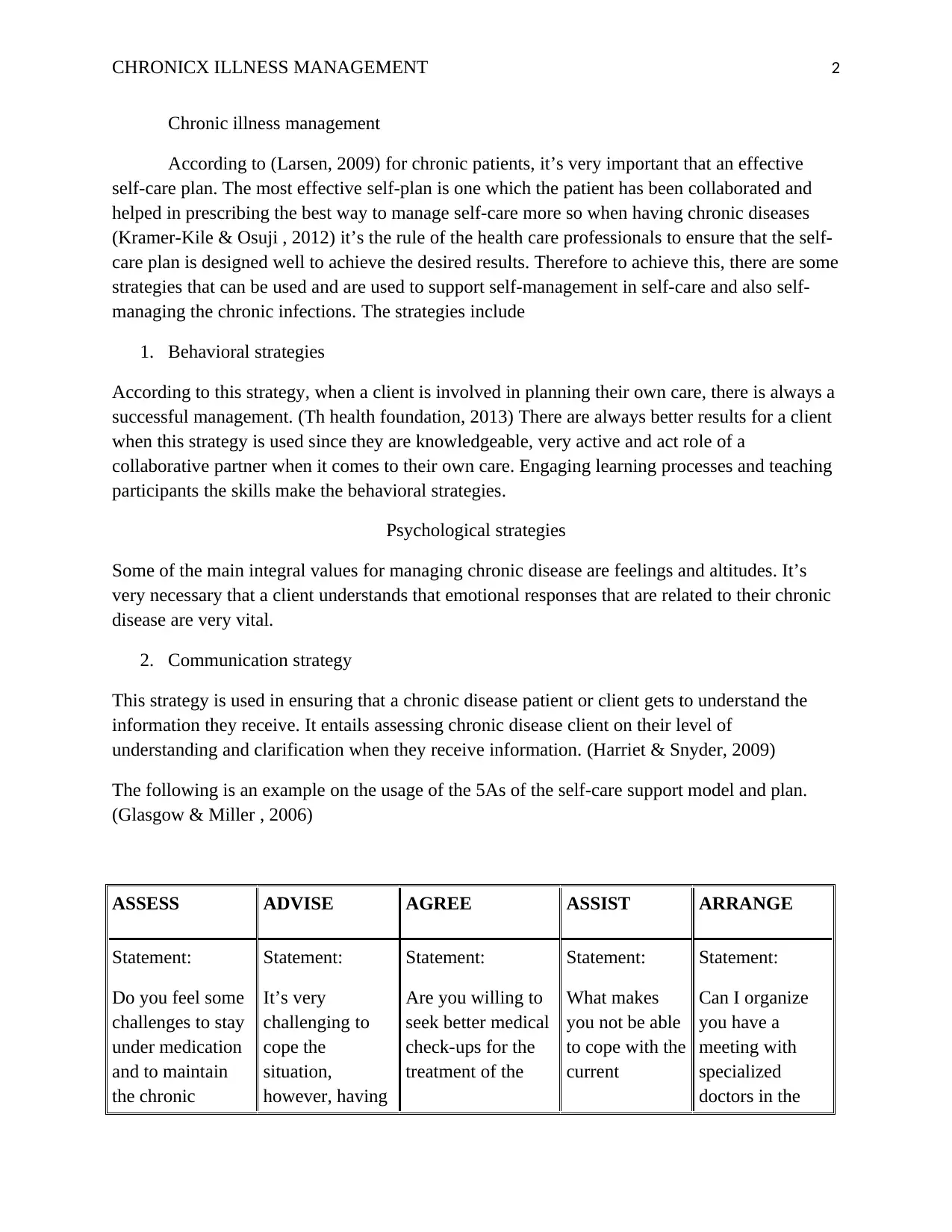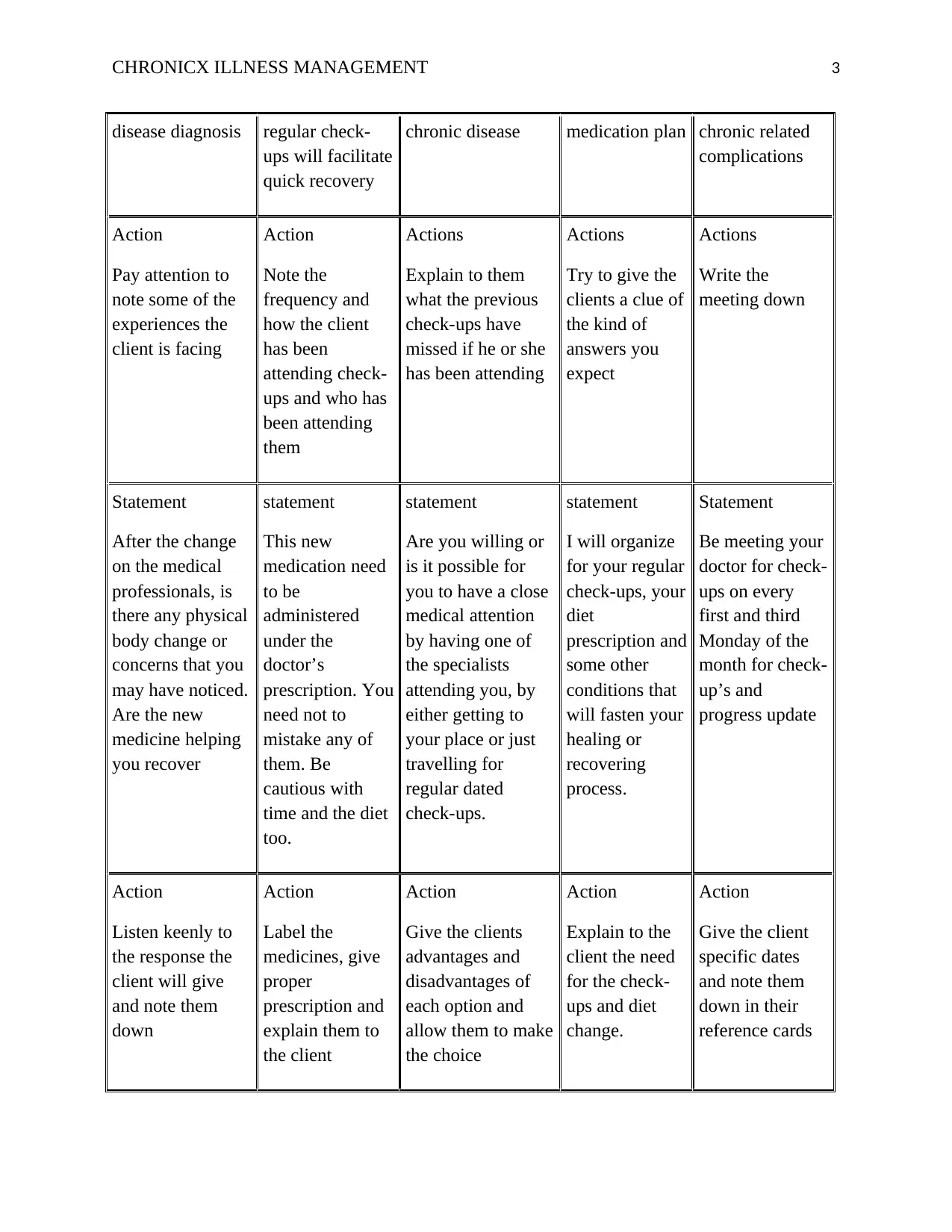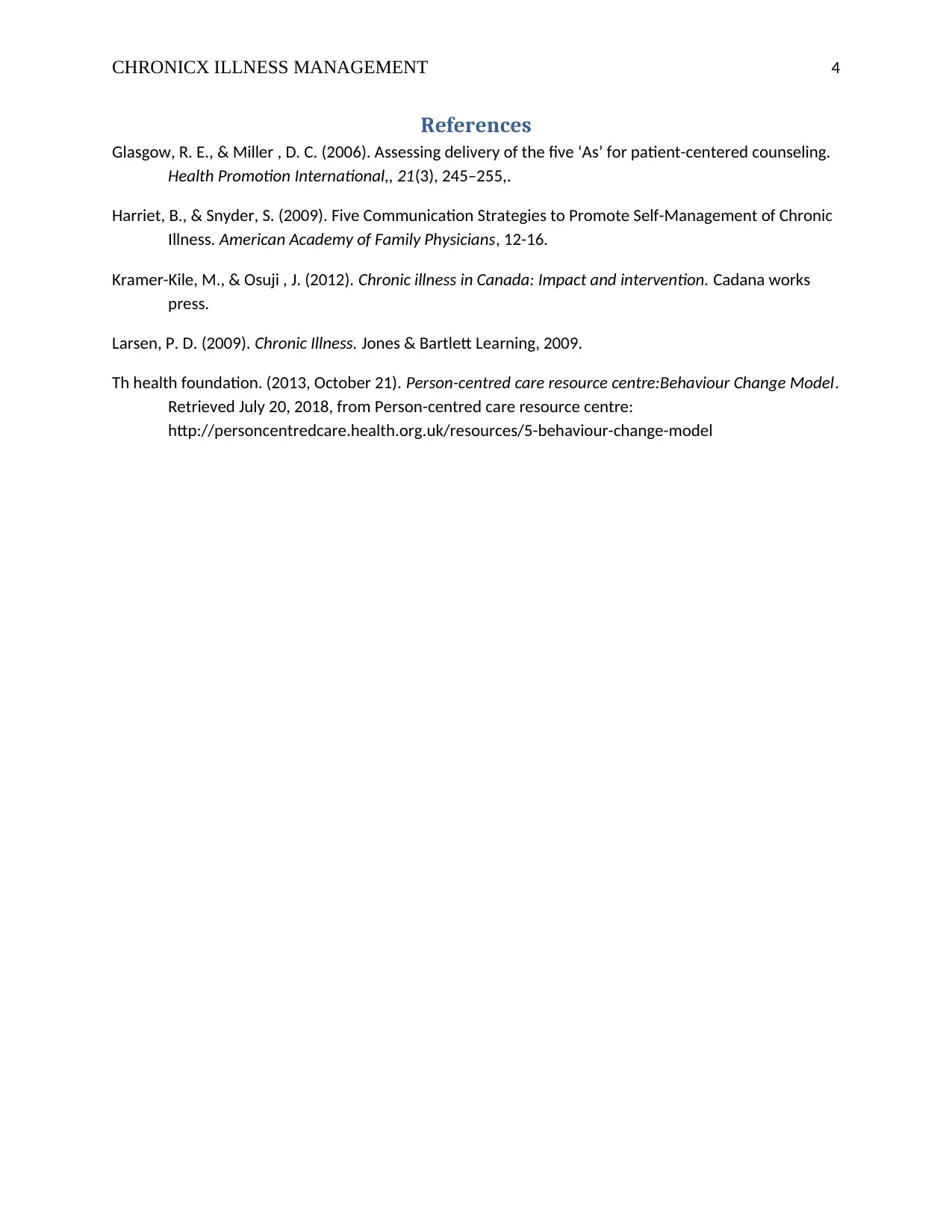A Report on Effective Chronic Illness Management Strategies
VerifiedAdded on 2023/06/09
|4
|870
|225
Report
AI Summary
This report delves into the strategies for managing chronic illnesses, emphasizing the importance of self-care plans and patient collaboration. It highlights behavioral, psychological, and communication strategies, including the 5 A's model (Assess, Advise, Agree, Assist, Arrange), to support self-management. The report discusses the significance of understanding emotional responses and effective communication between healthcare professionals and patients. It provides examples of applying the 5 A's model in managing chronic diseases, focusing on medication adherence, regular check-ups, and dietary changes. The report references key studies and resources to support its findings, offering a comprehensive overview of chronic illness management techniques.

Running head: CHRONIC ILLNESS MANAGEMENT
1
Name
Course
Lecturer
Date
1
Name
Course
Lecturer
Date
Paraphrase This Document
Need a fresh take? Get an instant paraphrase of this document with our AI Paraphraser

CHRONICX ILLNESS MANAGEMENT 2
Chronic illness management
According to (Larsen, 2009) for chronic patients, it’s very important that an effective
self-care plan. The most effective self-plan is one which the patient has been collaborated and
helped in prescribing the best way to manage self-care more so when having chronic diseases
(Kramer-Kile & Osuji , 2012) it’s the rule of the health care professionals to ensure that the self-
care plan is designed well to achieve the desired results. Therefore to achieve this, there are some
strategies that can be used and are used to support self-management in self-care and also self-
managing the chronic infections. The strategies include
1. Behavioral strategies
According to this strategy, when a client is involved in planning their own care, there is always a
successful management. (Th health foundation, 2013) There are always better results for a client
when this strategy is used since they are knowledgeable, very active and act role of a
collaborative partner when it comes to their own care. Engaging learning processes and teaching
participants the skills make the behavioral strategies.
Psychological strategies
Some of the main integral values for managing chronic disease are feelings and altitudes. It’s
very necessary that a client understands that emotional responses that are related to their chronic
disease are very vital.
2. Communication strategy
This strategy is used in ensuring that a chronic disease patient or client gets to understand the
information they receive. It entails assessing chronic disease client on their level of
understanding and clarification when they receive information. (Harriet & Snyder, 2009)
The following is an example on the usage of the 5As of the self-care support model and plan.
(Glasgow & Miller , 2006)
ASSESS ADVISE AGREE ASSIST ARRANGE
Statement:
Do you feel some
challenges to stay
under medication
and to maintain
the chronic
Statement:
It’s very
challenging to
cope the
situation,
however, having
Statement:
Are you willing to
seek better medical
check-ups for the
treatment of the
Statement:
What makes
you not be able
to cope with the
current
Statement:
Can I organize
you have a
meeting with
specialized
doctors in the
Chronic illness management
According to (Larsen, 2009) for chronic patients, it’s very important that an effective
self-care plan. The most effective self-plan is one which the patient has been collaborated and
helped in prescribing the best way to manage self-care more so when having chronic diseases
(Kramer-Kile & Osuji , 2012) it’s the rule of the health care professionals to ensure that the self-
care plan is designed well to achieve the desired results. Therefore to achieve this, there are some
strategies that can be used and are used to support self-management in self-care and also self-
managing the chronic infections. The strategies include
1. Behavioral strategies
According to this strategy, when a client is involved in planning their own care, there is always a
successful management. (Th health foundation, 2013) There are always better results for a client
when this strategy is used since they are knowledgeable, very active and act role of a
collaborative partner when it comes to their own care. Engaging learning processes and teaching
participants the skills make the behavioral strategies.
Psychological strategies
Some of the main integral values for managing chronic disease are feelings and altitudes. It’s
very necessary that a client understands that emotional responses that are related to their chronic
disease are very vital.
2. Communication strategy
This strategy is used in ensuring that a chronic disease patient or client gets to understand the
information they receive. It entails assessing chronic disease client on their level of
understanding and clarification when they receive information. (Harriet & Snyder, 2009)
The following is an example on the usage of the 5As of the self-care support model and plan.
(Glasgow & Miller , 2006)
ASSESS ADVISE AGREE ASSIST ARRANGE
Statement:
Do you feel some
challenges to stay
under medication
and to maintain
the chronic
Statement:
It’s very
challenging to
cope the
situation,
however, having
Statement:
Are you willing to
seek better medical
check-ups for the
treatment of the
Statement:
What makes
you not be able
to cope with the
current
Statement:
Can I organize
you have a
meeting with
specialized
doctors in the

CHRONICX ILLNESS MANAGEMENT 3
disease diagnosis regular check-
ups will facilitate
quick recovery
chronic disease medication plan chronic related
complications
Action
Pay attention to
note some of the
experiences the
client is facing
Action
Note the
frequency and
how the client
has been
attending check-
ups and who has
been attending
them
Actions
Explain to them
what the previous
check-ups have
missed if he or she
has been attending
Actions
Try to give the
clients a clue of
the kind of
answers you
expect
Actions
Write the
meeting down
Statement
After the change
on the medical
professionals, is
there any physical
body change or
concerns that you
may have noticed.
Are the new
medicine helping
you recover
statement
This new
medication need
to be
administered
under the
doctor’s
prescription. You
need not to
mistake any of
them. Be
cautious with
time and the diet
too.
statement
Are you willing or
is it possible for
you to have a close
medical attention
by having one of
the specialists
attending you, by
either getting to
your place or just
travelling for
regular dated
check-ups.
statement
I will organize
for your regular
check-ups, your
diet
prescription and
some other
conditions that
will fasten your
healing or
recovering
process.
Statement
Be meeting your
doctor for check-
ups on every
first and third
Monday of the
month for check-
up’s and
progress update
Action
Listen keenly to
the response the
client will give
and note them
down
Action
Label the
medicines, give
proper
prescription and
explain them to
the client
Action
Give the clients
advantages and
disadvantages of
each option and
allow them to make
the choice
Action
Explain to the
client the need
for the check-
ups and diet
change.
Action
Give the client
specific dates
and note them
down in their
reference cards
disease diagnosis regular check-
ups will facilitate
quick recovery
chronic disease medication plan chronic related
complications
Action
Pay attention to
note some of the
experiences the
client is facing
Action
Note the
frequency and
how the client
has been
attending check-
ups and who has
been attending
them
Actions
Explain to them
what the previous
check-ups have
missed if he or she
has been attending
Actions
Try to give the
clients a clue of
the kind of
answers you
expect
Actions
Write the
meeting down
Statement
After the change
on the medical
professionals, is
there any physical
body change or
concerns that you
may have noticed.
Are the new
medicine helping
you recover
statement
This new
medication need
to be
administered
under the
doctor’s
prescription. You
need not to
mistake any of
them. Be
cautious with
time and the diet
too.
statement
Are you willing or
is it possible for
you to have a close
medical attention
by having one of
the specialists
attending you, by
either getting to
your place or just
travelling for
regular dated
check-ups.
statement
I will organize
for your regular
check-ups, your
diet
prescription and
some other
conditions that
will fasten your
healing or
recovering
process.
Statement
Be meeting your
doctor for check-
ups on every
first and third
Monday of the
month for check-
up’s and
progress update
Action
Listen keenly to
the response the
client will give
and note them
down
Action
Label the
medicines, give
proper
prescription and
explain them to
the client
Action
Give the clients
advantages and
disadvantages of
each option and
allow them to make
the choice
Action
Explain to the
client the need
for the check-
ups and diet
change.
Action
Give the client
specific dates
and note them
down in their
reference cards
⊘ This is a preview!⊘
Do you want full access?
Subscribe today to unlock all pages.

Trusted by 1+ million students worldwide

CHRONICX ILLNESS MANAGEMENT 4
References
Glasgow, R. E., & Miller , D. C. (2006). Assessing delivery of the five ‘As’ for patient-centered counseling.
Health Promotion International,, 21(3), 245–255,.
Harriet, B., & Snyder, S. (2009). Five Communication Strategies to Promote Self-Management of Chronic
Illness. American Academy of Family Physicians, 12-16.
Kramer-Kile, M., & Osuji , J. (2012). Chronic illness in Canada: Impact and intervention. Cadana works
press.
Larsen, P. D. (2009). Chronic Illness. Jones & Bartlett Learning, 2009.
Th health foundation. (2013, October 21). Person-centred care resource centre:Behaviour Change Model.
Retrieved July 20, 2018, from Person-centred care resource centre:
http://personcentredcare.health.org.uk/resources/5-behaviour-change-model
References
Glasgow, R. E., & Miller , D. C. (2006). Assessing delivery of the five ‘As’ for patient-centered counseling.
Health Promotion International,, 21(3), 245–255,.
Harriet, B., & Snyder, S. (2009). Five Communication Strategies to Promote Self-Management of Chronic
Illness. American Academy of Family Physicians, 12-16.
Kramer-Kile, M., & Osuji , J. (2012). Chronic illness in Canada: Impact and intervention. Cadana works
press.
Larsen, P. D. (2009). Chronic Illness. Jones & Bartlett Learning, 2009.
Th health foundation. (2013, October 21). Person-centred care resource centre:Behaviour Change Model.
Retrieved July 20, 2018, from Person-centred care resource centre:
http://personcentredcare.health.org.uk/resources/5-behaviour-change-model
1 out of 4
Related Documents
Your All-in-One AI-Powered Toolkit for Academic Success.
+13062052269
info@desklib.com
Available 24*7 on WhatsApp / Email
![[object Object]](/_next/static/media/star-bottom.7253800d.svg)
Unlock your academic potential
Copyright © 2020–2025 A2Z Services. All Rights Reserved. Developed and managed by ZUCOL.




